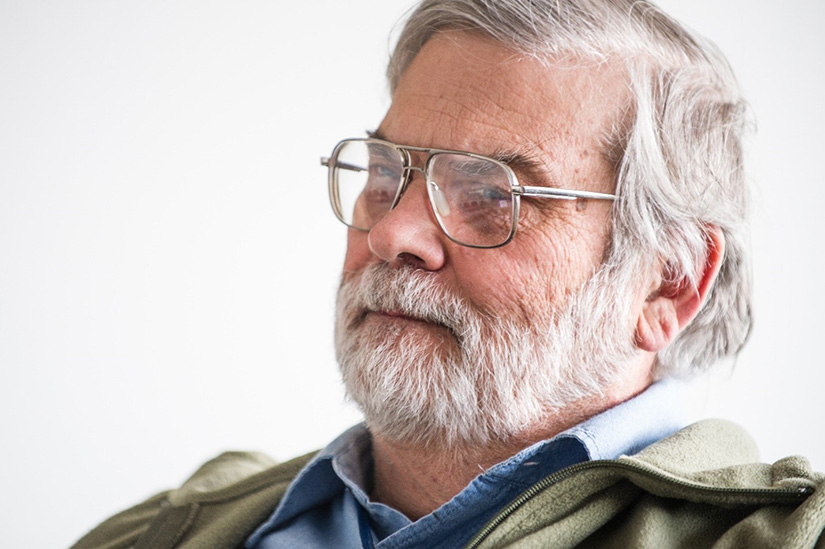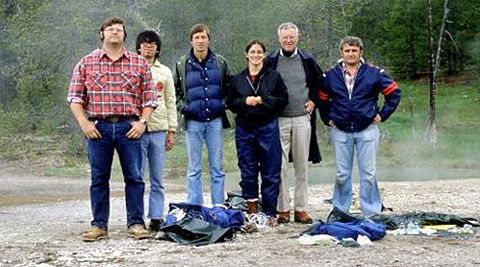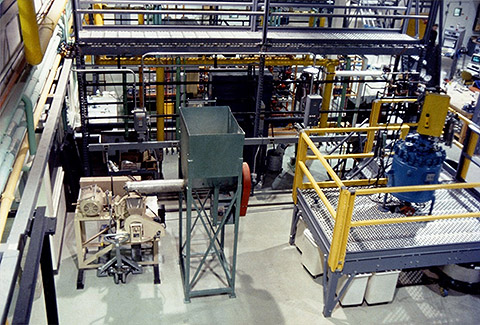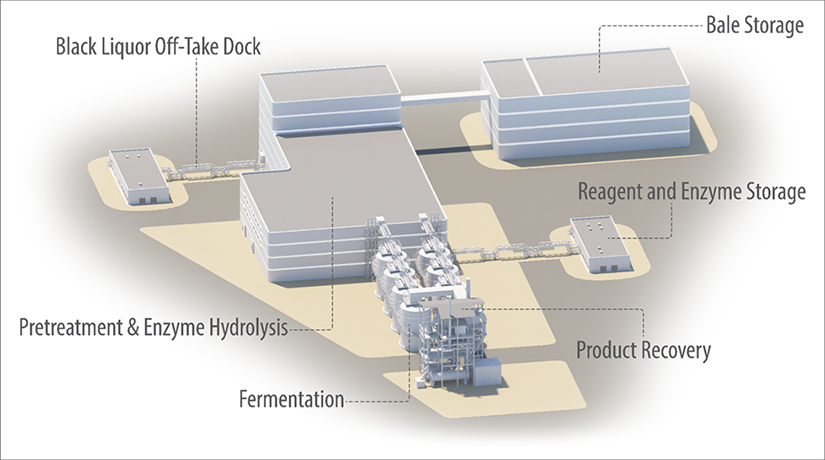NREL Biofuel Scientist Honored by Colorado Governor for Lifetime of Achievements
Over His 40-Plus-Year Career, Michael E. Himmel Has Unraveled Complexities of Using Enzymes To Deconstruct Lignocellulosic Biomass for Climate-Friendly Fuels

A single scientist cannot own a field of study, science itself a practice built through a community of minds. Nor is one scientific article the final word on a subject. Conclusions change and insights are revisited as new data and evidence emerges.
But if anyone can be said to have defined a field of science, it can undoubtedly be said of Michael E. Himmel.
During his more than 40-year career as a researcher at the National Renewable Energy Laboratory (NREL), Himmel has shown the world it is possible to make biofuels from the fibrous, inedible, often discarded parts of plants, known to biologists as lignocellulosic biomass. Most remarkably, he has demonstrated how to do so at a scale and economy needed to decarbonize transportation.
Now, in recognition of his outstanding contributions on biofuels processing and enzyme design, Himmel has received a Lifetime Achievement Award from Colorado Gov. Jared Polis. Lt. Gov. Dianne Primavera presented Himmel the award on behalf of Gov. Polis during a Dec. 14, 2022, ceremony at the Denver Museum of Nature and Science, the 12th such event presented by CO-LABS to celebrate Colorado’s top scientists and research accomplishments. CO-LABS is a consortium of federally funded Colorado research institutions that aims to “make Colorado the hub of scientific research addressing the planet's most crucial challenges.”
The award is a testament to the impact of Himmel’s long career, which has featured discoveries on the covers of scientific journals and technologies developed right up to the cusp of commercialization.
Feet in Two Worlds: On the Farm, in the Lab
In 1952, Himmel was born in Ohio into a family of academics. His father and grandfather, both college professors, passed on a heritage of hard work and scholastic values to Himmel, who himself received a Ph.D. in biochemistry from Colorado State University in 1980.
But his interest in biomass may have “roots” off the university campus. During his school years in Greeley, Colorado, between wrestling team workouts, he spent weekends and summers working as a truck and tractor mechanic in the surrounding farming community.

“I think I was sort of a rare chemistry student that took chemistry courses during the day, then drove to the countryside where I worked on farm equipment, sometimes in the field,” Himmel said of his first decade in Colorado. “I had a close look at both cultures, and I think that experience allowed me to approach the biofuels challenge from a different viewpoint relative to my peers. It kept me humble.”
He quickly developed an aptitude for both chemistry and mechanical engineering, which served him well when in 1980 he accepted a postdoctoral position at NREL, then called the Solar Energy Research Institute.
“When I began here in 1980, the field of lignocellulosic biomass conversion to fuels really didn't exist,” he said. “We literally had to make all of our research materials, including the biomass substrates.”
True, the oil embargo in the 1970s had helped stimulate a corn ethanol industry, but that was built around the plant’s starchy kernels. Turning its tougher (and far more abundant) lignocellulosic leaves, stalks, and cobs into fuel proved far more difficult. Lignocellulose—the primary structural component of plants—exhibits a high degree of recalcitrance, or “the natural resistance of plant cell walls to microbial and enzymatic deconstruction” (to use Himmel’s definition in his seminal 2007 Science article).
Depending on the process used to make it, biofuel made from lignocellulose can net deep reductions in greenhouse gas emissions compared to fossil fuels and even first-generation biofuels. For example, ethanol made from lignocellulosic biomass, rather than corn starch, can reduce emissions 88% to 108% on a life-cycle basis, according to the U.S. Department of Energy.
For Himmel, overcoming biomass recalcitrance and unlocking the opportunity of cellulosic biofuels would mean spending untold hours researching cellulase enzymes. Common in nature, cellulases decompose the stems, leaves, and roots of trees and plants, making their sugars and other nutrients available for other organisms.
To speed up that process for industry, though, Himmel would first need to map out the biological mechanisms by which they function. He started by designing a facility where he could actually do that research.
Both Chemist and Engineer: Himmel Built a Program From the Ground Up
“In those days, NREL didn't have a biofuels process engineer—and even though I was formally trained as a biochemist, I knew that I could build things,” Himmel reflected when thinking back to the early days at NREL. “I know that's not what a biochemist should be doing, but I think the point here is that sometimes when you take a job with a new company you've got to do what it takes to make that company successful.”

Starting with Colorado-produced wheat straw, about $50,000 from the U.S. Department of Energy, and a newly created high bay space in NREL’s Field Test Laboratory Building, Himmel started building a small pretreatment pilot plant from the ground up. He bought grinding mills, processing tanks, and fermenters. He was tested and received a license to drive NREL’s forklifts. He designed and built a plumbing system to shuttle and control liquids and gases between newly assembled equipment. He patented technologies and started building a team of world-class scientific talent.
Thirty-five years later, this legacy is captured today in a state-of-the-art facility: NREL’s Integrated Biorefinery Research Facility (IBRF).
From NREL’s laboratories, Himmel has led hundreds of scientific studies in protein biochemistry, recombinant technology, enzyme engineering, microorganism discovery, macromolecular physico-chemistry, as well as all key unit operations in biofuels production. Himmel became as comfortable in esoteric protein engineering as in fast-paced, high-stakes applied science. He was able to straddle both roles, much like he had done when working in Greeley several decades before.
Himmel has been so prolific that his byline has become a placeholder for biofuels researchers everywhere. For example, his research into low-cost formulations for cellulase enzymes earned him an R&D 100 Award in 2004. His citation metrics rival the collective work of entire research teams and organizations, having written over 500 papers, 11 books, and 40 patents.
Study by study, Himmel has shown industry how to cost-effectively wield enzymes, in combination with other preprocessing techniques, to break the chemical bonds of biomass and free the energy locked inside. Bringing those insights to the world outside the lab has broad implications for a decarbonized energy future. Just look at the pilot cellulosic ethanol facility, called SAFFiRE, designed for construction in Nevada, Iowa.

Fruit of a Rich Career: Sustainable Aviation Fuel From Renewable Ethanol
Himmel is seeing the fruit of his career ripen in the form of a pilot plant supported by D3MAX LLC, the U.S. Department of Energy, Southwest Airlines, NREL, LanzaJet, and others. Called SAFFiRE or “Sustainable Aviation Fuel From [i] Renewable Ethanol,” the 10-ton-per-day lignocellulosic ethanol facility is long anticipated in the push to turn agricultural waste—like corn stover—into sustainable aviation fuel. Lincolnway Energy, a corn ethanol plant located in Nevada, Iowa, plans to host the SAFFiRE pilot project.
SAFFiRE is among a handful of economical, proven technologies that could produce a biofuel that is both less expensive than petroleum-based jet fuel and can reduce carbon emissions dramatically—over 80% on a life-cycle basis.
Using NREL’s patent-pending deacetylation and mechanical refining process—drawing liberally from Himmel and colleagues’ knowledge and experience—the project sidesteps the expenses and challenges of previous efforts to turn lignocellulosic biomass into fuel. By doing so, it could boost ethanol yields by 14% and lower its cost by 33 cents per gallon.
Traits of Award-Winning Scientific Impact: “Generosity, Kindness, Openness”
So, what has made Himmel so impactful as a scientist? What is the secret sauce behind his award-winning achievements?
According to Maureen McCann, NREL’s biosciences center director, it may have as much to do with his remarkable mind as his generosity and impact on the people he has worked with over the years.
“Personally, I've benefited from his generosity and kindness and really his openness to thinking in innovative and creative ways,” she said. “I think his legacy is going to be partly the scientific contributions that he's made directly in research, but then also his intellectual leadership in bioenergy research at large. My center at NREL is absolutely populated with protégés who have benefited from Mike's mentorship.”
For Adam Bratis, associate laboratory director for NREL’s bioenergy program, Himmel’s impact comes back to his ability to turn basic science into something everyone can benefit from. He recalled what a prominent biotech industry scientist said about Himmel during one of his DOE Bioenergy Technology Office Peer Review presentations over a decade ago.
“Her comment was that she comes every year primarily to hear Mike,” he said. “She said she always learns something new about enzymes. He always has ideas on what industry should be thinking about next.”
Maybe that sums up the tenor of Himmel’s career: the ability to delve into the furthest corners of biological sciences and bring back insights solid enough to build a business around. Like basic ingredients for a complete and nourishing meal, he has supplied what is needed to build a vibrant bioeconomy without the climate cost.
Last Updated May 28, 2025
